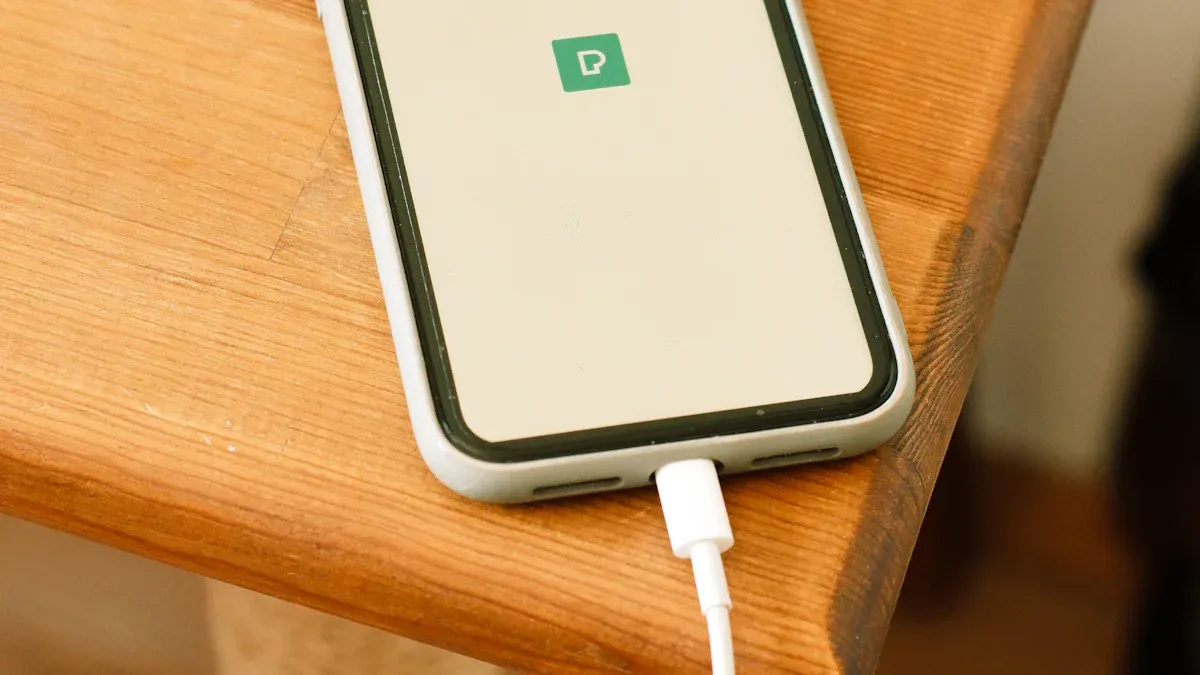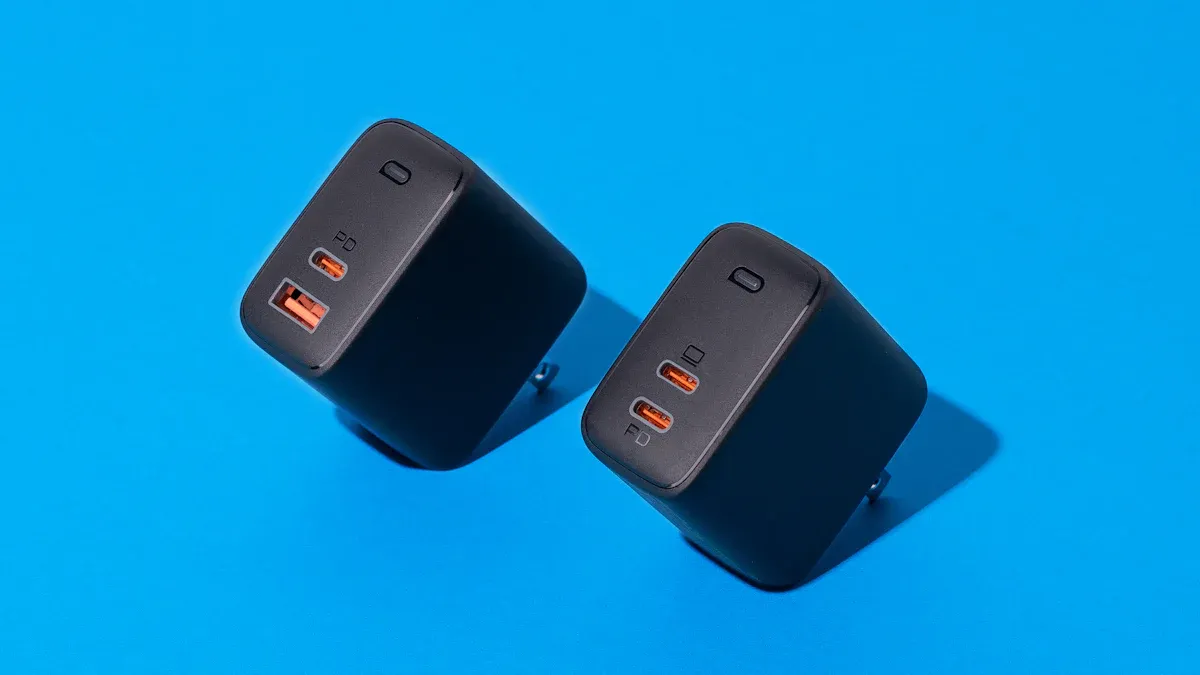The demand for fast charging is growing rapidly, reshaping how you interact with consumer electronics. Recent market data highlights this trend:
- The global wireless charging market reached $15.9 billion in 2022 and is projected to grow at a staggering CAGR of 24.2% through 2030.
- By 2030, this market is expected to surpass $80 billion, driven by the rising adoption of fast-charging technologies.
- Over 60% of the market share in 2022 came from consumer electronics, showcasing their pivotal role in driving demand.
PD charger manufacturers are meeting this demand by creating innovative charging solutions. From integrating USB Type-C technology to offering eco-friendly designs, they are focused on delivering efficiency and sustainability. These advancements ensure your devices charge faster while aligning with your preferences for convenience and environmental responsibility.
Understanding PD Chargers and Their Role in Fast Charging
What Is Power Delivery (PD) Technology?
Power Delivery (PD) technology is a universal charging standard that enhances how your devices receive power. Unlike older methods, PD allows for higher power levels and smarter power management. For example, USB-PD can deliver up to 20 volts and 5 amps, making it suitable for high-power devices like laptops and tablets.
The technology also supports dynamic power negotiation. This means your charger and device communicate to determine the optimal power level, ensuring efficient and safe charging. PD technology is built on USB Type-C standards, which are widely compatible across modern devices.
| Specification Type | Voltage | Current | Description |
|---|---|---|---|
| USB 2.0 | 5 V | 500 mA | Default Current |
| USB 3.1 | 5 V | 900 mA | Default Current |
| USB Type-C® @ 3.0 A | 5 V | 3 A | Supports higher power devices |
| USB-PD | Up to 20 V | Up to 5 A | Configurable power levels for modern devices |
Why Are PD Chargers Essential for Modern Devices?
Modern devices demand more power to support advanced features. PD chargers meet this need by offering fast charging and universal compatibility. For instance, a 20W PD charger can charge an iPhone 14 to 60% in just 30 minutes, compared to only 20% with a traditional 5W charger.
PD chargers also reduce the need for multiple charging solutions. You can use one charger for your phone, tablet, and even your laptop. This versatility makes them an essential tool for your daily life.
- USB PD supports voltages up to 48 volts, enabling high-speed charging.
- It optimizes charging efficiency through dynamic power negotiation.
- It works with a wide range of devices, simplifying your charging setup.
Key Benefits of PD Chargers for Consumers
PD chargers offer several advantages that improve your charging experience:
- Faster Charging: They deliver high-speed charging, saving you time.
- Universal Compatibility: You can use one charger for multiple devices, reducing clutter.
- Eco-Friendly: By replacing multiple chargers, PD chargers help reduce electronic waste.
- Enhanced Safety: Dynamic power negotiation ensures your devices charge safely without overheating.
| Feature | USB PD Chargers | Traditional Chargers |
|---|---|---|
| Charging Multiple Devices | Yes | No |
| Voltage Support | Up to 48 volts | Limited (typically 5-20 volts) |
| Power Negotiation | Dynamic | Static |
| Compatibility | Universal across devices | Often proprietary |
| Environmental Impact | Reduces electronic waste | Increases waste due to multiple chargers |
PD chargers are not just about convenience. They represent a smarter, more sustainable way to power your devices.
Innovations by PD Charger Manufacturers
Advancements in Charging Speed and Power Output
PD charger manufacturers are revolutionizing charging technology by pushing the boundaries of speed and power output. Wide bandgap (WBG) semiconductors, such as silicon carbide (SiC) and gallium nitride (GaN), play a pivotal role in these advancements. These materials significantly enhance efficiency and reduce energy losses during charging. For example, SiC devices can lower switching losses by up to 90%, making them ideal for high-power applications like electric vehicles (EVs). GaN technology, on the other hand, allows for the production of compact chargers with higher power outputs, such as the 100w pd charger, which can charge laptops, tablets, and smartphones at lightning-fast speeds.
Fast-charging stations equipped with WBG semiconductors are also cutting charging times by 50%. This improvement is crucial for meeting the growing demand for quick and efficient charging solutions. Additionally, innovative strategies like pulse charging further optimize the process. By adjusting the pulse width, these chargers not only speed up charging but also extend battery life, ensuring your devices last longer.
Enhancing Device Compatibility with USB-C Standards
PD charger manufacturers are setting new benchmarks in device compatibility by adhering to USB-C standards. These standards ensure seamless integration across a wide range of devices, from smartphones to laptops. For instance, USB 3.2 requires capturing all four lanes of data to assess crosstalk impact effectively. Manufacturers must balance performance across these lanes to deliver accurate real-world results. This meticulous testing guarantees that chargers like the 100w pd charger perform reliably under various conditions.
| Aspect | Description |
|---|---|
| Testing Requirements | USB 3.2 requires capturing all four lanes of data to assess crosstalk impact effectively. |
| Performance Balancing | Manufacturers must balance performance across all four pairs of signals for accurate real-world testing. |
| Multi-lane Specifications | The multi-lane operational specification is designed for higher bandwidth, introducing new test challenges. |
Staying updated with the latest USB4 revisions is equally important. These updates introduce new requirements that impact product design and performance. By adhering to these specifications, manufacturers ensure a seamless user experience, allowing you to use a single charger for multiple devices without compatibility issues.
Eco-Friendly and Sustainable Charger Designs
Sustainability is becoming a core focus for PD charger manufacturers. Many companies are now designing chargers using recycled materials to reduce environmental impact. For example, EcoBlvd’s PowerPlant charger is made entirely from post-consumer recycled materials, minimizing waste and conserving resources. Similarly, the LifeVine charging cable uses Remerge™ recycled plastic, offering durability and sustainability in one package.
The average American household owns around 8.6 devices that require charging. This contributes to a significant amount of e-waste. By choosing eco-friendly chargers, such as the 100w pd charger, you can help reduce this waste while supporting sustainable practices. According to the Environmental Protection Agency (EPA), e-waste is the fastest-growing segment of municipal waste in the U.S., with over 400 million electronics discarded annually. Opting for sustainable charging solutions can play a vital role in addressing this issue.
PD charger manufacturers are also promoting renewable energy initiatives. Some companies donate a portion of their sales to renewable energy projects, further emphasizing their commitment to sustainability. These efforts not only benefit the environment but also align with consumer preferences for eco-conscious products.
Market Trends Shaping the PD Charger Industry
Growing Popularity of Multi-Device Charging Solutions
Multi-device charging solutions are becoming increasingly popular as consumers seek convenience and efficiency. These chargers allow you to power multiple devices simultaneously, reducing clutter and simplifying your charging setup. Market research highlights this trend, showing significant growth in the industry:
| Year | Market Size (USD Billion) | CAGR (%) |
|---|---|---|
| 2023 | 1.5 | N/A |
| 2032 | 4.2 | 12.3 |
This growth reflects the rising demand for versatile charging solutions that cater to households with multiple devices. For example, a 100w pd charger can charge your laptop, tablet, and smartphone at the same time, making it an ideal choice for families or professionals. As more devices adopt USB-C standards, multi-device chargers are becoming essential for fast charging and universal compatibility.
Adoption of GaN Technology for Compact and Efficient Chargers
Gallium Nitride (GaN) technology is transforming the charger industry by enabling compact designs and higher efficiency. If you’ve ever wished for a smaller charger that delivers powerful performance, GaN technology is the answer. It allows manufacturers to create chargers like the 100w pd charger, which combines portability with fast charging capabilities.
| Benefit/Application | Description |
|---|---|
| High Efficiency | GaN technology enables higher efficiency in power conversion, leading to reduced energy waste. |
| Power Density | GaN allows for more compact designs, increasing the power density of chargers and other devices. |
| Miniaturization | The smaller size of GaN components contributes to the miniaturization of chargers, making them more portable. |
| Thermal Performance | GaN devices exhibit superior thermal performance, which enhances reliability and longevity. |
| Adoption in Industries | GaN is being adopted in consumer electronics, electric vehicles, and telecommunications, indicating a significant market shift. |
GaN chargers also excel in thermal performance, ensuring your devices stay safe during charging. Their adoption in industries like AI data centers and home appliances highlights their versatility and efficiency. With GaN technology, you can enjoy compact, reliable chargers that meet your fast charging needs.
Rising Consumer Demand for Portability and Convenience
Portable charging solutions are becoming a necessity as you rely more on mobile technology. Shared charging cases, designed for public spaces like cafes and airports, reflect this trend. These cases allow you to charge your devices conveniently while on the go.
The Portable Device Charging Kiosk Market is projected to reach 1.89 billion USD in 2023, driven by demand for accessible charging solutions in high-traffic areas. Whether you’re at a mall or an airport, portable kiosks provide a quick and easy way to keep your devices powered. This growth underscores the importance of portability in modern charging solutions.
You’ll also find portable chargers designed for outdoor use, catering to consumers who need reliable power during travel or outdoor activities. These innovations align with your preference for convenience, ensuring you can charge your devices anytime, anywhere.
Challenges Faced by PD Charger Manufacturers
Balancing Cost-Effectiveness with High-Quality Standards
You expect your chargers to be affordable yet reliable. For PD charger manufacturers, achieving this balance is a constant challenge. High-quality materials like gallium nitride (GaN) and advanced safety features increase production costs. However, cutting corners to reduce expenses can compromise performance and safety.
To address this, manufacturers invest in efficient production methods and bulk sourcing of materials. These strategies help lower costs without sacrificing quality. For example, using automated assembly lines reduces labor expenses while maintaining precision. This ensures you receive a charger that is both cost-effective and dependable.
Meeting Regulatory and Safety Compliance Requirements
Regulatory compliance is critical for ensuring your safety. PD charger manufacturers must meet strict standards to prevent issues like overheating or electrical hazards. For instance, the EU Directive (EU 2022/2380) mandates that all devices with USB Type-C ports comply with universal charging standards by December 28, 2024.
| Compliance Requirement | Description |
|---|---|
| PD Compliance Plan | Ensures power sources meet voltage and timing parameters during transitions. |
| DRP Device Testing | Verifies compliance by testing all available source PDOs through role swaps. |
| EU Directive 2022/2380 | Enforces universal charger regulations for 13 device categories by 2026. |
These regulations ensure your chargers are safe and compatible with modern devices. However, meeting these standards requires rigorous testing and certification, which can delay product launches and increase costs.
Keeping Pace with Rapid Technological Advancements
Technology evolves quickly, and you expect your chargers to keep up. Manufacturers face challenges in integrating new technologies like generative AI and IoT while managing complex supply chains. The semiconductor industry, essential for advancements in AI and IoT, plays a crucial role in this process.
| Key Insights | Description |
|---|---|
| Growth Rate | Software is projected to grow 14% annually, driving demand for advanced chargers. |
| Integration Challenges | Managing multicloud infrastructures and new tech integration is complex. |
| Regulatory Impact | Geopolitical risks and regulations affect technology strategies. |
Despite these hurdles, manufacturers see opportunities for innovation. By investing in research and development, they create chargers that are faster, more efficient, and compatible with future devices. This ensures you always have access to cutting-edge charging solutions.
How PD Charger Manufacturers Are Overcoming Challenges
Investing in Research and Development for Innovation
PD charger manufacturers are investing heavily in research and development to meet your growing demand for faster and more efficient charging solutions. These investments focus on adopting cutting-edge technologies and enhancing product performance.
- GaN technology is revolutionizing chargers by improving efficiency and reducing size.
- Smart charging technologies optimize energy delivery, ensuring your devices charge safely and quickly.
- Multi-port chargers are being developed to meet the needs of households with multiple devices.
- Fast charging capabilities are becoming a priority as consumers expect quicker power-ups for their devices.
These innovations not only improve your charging experience but also set new benchmarks for the industry. By prioritizing R&D, manufacturers ensure their products remain relevant in a rapidly evolving market.
Collaborating with OEMs for Seamless Integration
Strategic partnerships between PD charger manufacturers and OEMs are driving advancements in charging technology. These collaborations focus on creating integrated solutions that enhance energy efficiency and reduce device size.
- Manufacturers are working with tech companies to improve charging infrastructure for modern devices.
- Smart charging features are being integrated to optimize energy delivery, which is especially important for industries with high energy costs.
- Innovations in PD charger technology are making chargers more compact while maintaining high power output.
These partnerships ensure that your chargers work seamlessly with a wide range of devices, from smartphones to laptops. By collaborating with OEMs, manufacturers can deliver products that meet your expectations for reliability and performance.
Scaling Production with Sustainable Manufacturing Practices
Sustainability is becoming a key focus for PD charger manufacturers as they scale production to meet rising demand. Manufacturing contributes significantly to global greenhouse gas emissions, making sustainable practices essential.
- New regulations, such as SEC and California Climate Reporting Rules, require manufacturers to disclose sustainability data.
- Large companies are demanding sustainability data from their supply chains, driven by consumer preferences.
- Frameworks like EcoVadis and CDP are helping manufacturers track and improve their environmental impact.
You play a role in this shift. Studies show that 79% of consumers change their purchase preferences based on sustainability. By adopting eco-friendly practices, manufacturers not only reduce emissions but also align with your values. Even small improvements in production can lead to substantial reductions in energy use and waste, ensuring a greener future for charging technology.
PD charger manufacturers play a vital role in meeting your need for fast-charging solutions. Their innovations in speed, compatibility, and eco-friendly designs are shaping the future of charging technology. The market reflects this growth:
| Aspect | Details |
|---|---|
| Market Value (2023) | Estimated to be worth US$ million |
| Forecast (2030) | Readjusted size of US$ million |
| CAGR (2024-2030) | % |
| Key Drivers | Strong demand for fast-charging solutions, especially for flagship smartphones supporting PD fast charging. |
By focusing on collaboration and sustainable practices, manufacturers ensure their products align with your expectations and environmental values. This commitment guarantees a smarter, greener future for charging technology.
FAQ
What makes PD chargers different from traditional chargers?
PD chargers deliver faster charging by using higher power levels and dynamic power negotiation. They also support universal compatibility with USB-C standards, allowing you to charge multiple devices with one charger. Traditional chargers lack these advanced features and often work with limited devices.
Can I use a PD charger with older devices?
Yes, you can use a PD charger with older devices. However, the charging speed depends on the device’s compatibility. Older devices may not support fast charging, but the PD charger will adjust its power output to safely charge your device.
Are PD chargers safe for my devices?
Absolutely! PD chargers use dynamic power negotiation to ensure safe charging. This feature prevents overheating and overcharging. Always choose certified PD chargers from reputable manufacturers to guarantee safety and compatibility with your devices.
Do PD chargers work with non-USB-C devices?
Yes, but you’ll need an adapter or cable with the appropriate connector. For example, you can use a USB-C to Lightning cable to charge an iPhone. The PD charger will still provide efficient and safe charging for your non-USB-C device.
How do I know if my device supports PD charging?
Check your device’s specifications or user manual. Look for terms like “USB Power Delivery” or “PD fast charging.” Many modern smartphones, tablets, and laptops support PD charging. If unsure, consult the manufacturer’s website for compatibility details.



